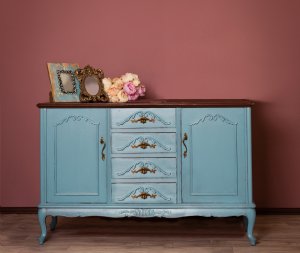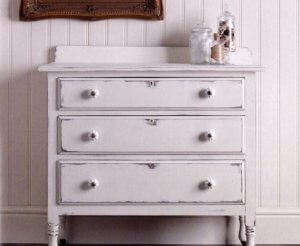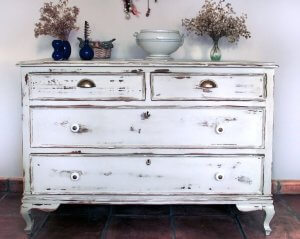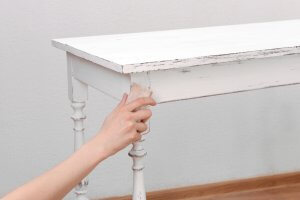Popular Distressing Techniques for Furniture

In the world of interior decor, not everything’s about making your home look sparkling new. If you love all things vintage, you can use distressing techniques to give your furniture that charming antique look.
We all want furniture that matches the style of our home. But what you have to remember is that there are so many different ways to go about it. With a little imagination, you can transform your everyday furniture into beautiful and original decorative elements.
While you might not always find aged furniture in decorating stores, that doesn’t mean you can’t make it yourself at home. So, if you want to create your own vintage furniture, these techniques might be exactly what you need.
Distressing techniques for the vintage look

As you’ve probably heard, vintage is in. However, not all antique or antique-style furniture is actually vintage. It’s important to make this distinction and to understand that not everything is part of this trend.
The vintage trend involves decorating your home to give it an antique-style appearance, without your furniture losing any of its functionality. Vintage furniture is very different from modern furniture, and works perfectly in rustic-style homes, giving them a sense of charm and originality.
Just because a piece of furniture is old, doesn’t mean it’s useless.
Distressing techniques – the chalk effect

One interesting way to distress your furniture is to use the chalk effect. This simple technique is super easy to do and suitable for any new furniture you want to give that vintage look.
- Sand the surface of the wood with medium-grain sandpaper so as not to damage the surface.
- To obtain an aged, patina effect, mix white chalk paint with water to dilute it.
- The next step is to paint the whole surface. The idea is to create light, thin layers, so try not to paint it on too thick.
- To create the distressed look, wipe a sponge over the surface of the wood, working in the direction of the grain. You’ll notice that some sections are whiter than others, and the color will be somewhat diluted and uneven in places.
- It’s important to make sure the wood is clearly visible, and not obscured by the paint.
The wax technique

Another popular and creative distressing technique is to use wax:
- Dilute your base paint with water and paint the entire surface of the wood, making sure to cover every inch. Leave it to dry before moving on to the next step.
- Next, take a candle and rub it over the surface to apply wax to the wood.
- Next, apply a layer of water-based varnish. For this step, it’s best to choose a different color. For example, if the base layer is green, you could choose white or brown varnish. Allow it to dry, making sure it’s completely set.
- Finally, sand the surface, so that any sections of varnish covering the wax peel off.
- If you really want to emphasize the aged look, you could apply a light-colored bitumen paint.
– The old can become new again.
The sanding technique

One final quick and simple distressing technique is to sand the surface of your wooden furniture. Simply use sandpaper to gradually wear away the paint.
The aim is to create the effect of superficial deterioration. Always work in the direction of the grain, making some sections look more worn than others. If you’re going to be using your furniture often, you can paint the top surface and leave it un-sanded to avoid any accidental damage to the wood.
If you want, you can also apply varnish to give your furniture that extra bit of protection. In any case, any imperfections or natural wear-and-tear can help to give your furniture that authentic vintage look.
In the world of interior decor, not everything’s about making your home look sparkling new. If you love all things vintage, you can use distressing techniques to give your furniture that charming antique look.
We all want furniture that matches the style of our home. But what you have to remember is that there are so many different ways to go about it. With a little imagination, you can transform your everyday furniture into beautiful and original decorative elements.
While you might not always find aged furniture in decorating stores, that doesn’t mean you can’t make it yourself at home. So, if you want to create your own vintage furniture, these techniques might be exactly what you need.
Distressing techniques for the vintage look

As you’ve probably heard, vintage is in. However, not all antique or antique-style furniture is actually vintage. It’s important to make this distinction and to understand that not everything is part of this trend.
The vintage trend involves decorating your home to give it an antique-style appearance, without your furniture losing any of its functionality. Vintage furniture is very different from modern furniture, and works perfectly in rustic-style homes, giving them a sense of charm and originality.
Just because a piece of furniture is old, doesn’t mean it’s useless.
Distressing techniques – the chalk effect

One interesting way to distress your furniture is to use the chalk effect. This simple technique is super easy to do and suitable for any new furniture you want to give that vintage look.
- Sand the surface of the wood with medium-grain sandpaper so as not to damage the surface.
- To obtain an aged, patina effect, mix white chalk paint with water to dilute it.
- The next step is to paint the whole surface. The idea is to create light, thin layers, so try not to paint it on too thick.
- To create the distressed look, wipe a sponge over the surface of the wood, working in the direction of the grain. You’ll notice that some sections are whiter than others, and the color will be somewhat diluted and uneven in places.
- It’s important to make sure the wood is clearly visible, and not obscured by the paint.
The wax technique

Another popular and creative distressing technique is to use wax:
- Dilute your base paint with water and paint the entire surface of the wood, making sure to cover every inch. Leave it to dry before moving on to the next step.
- Next, take a candle and rub it over the surface to apply wax to the wood.
- Next, apply a layer of water-based varnish. For this step, it’s best to choose a different color. For example, if the base layer is green, you could choose white or brown varnish. Allow it to dry, making sure it’s completely set.
- Finally, sand the surface, so that any sections of varnish covering the wax peel off.
- If you really want to emphasize the aged look, you could apply a light-colored bitumen paint.
– The old can become new again.
The sanding technique

One final quick and simple distressing technique is to sand the surface of your wooden furniture. Simply use sandpaper to gradually wear away the paint.
The aim is to create the effect of superficial deterioration. Always work in the direction of the grain, making some sections look more worn than others. If you’re going to be using your furniture often, you can paint the top surface and leave it un-sanded to avoid any accidental damage to the wood.
If you want, you can also apply varnish to give your furniture that extra bit of protection. In any case, any imperfections or natural wear-and-tear can help to give your furniture that authentic vintage look.
All cited sources were thoroughly reviewed by our team to ensure their quality, reliability, currency, and validity. The bibliography of this article was considered reliable and of academic or scientific accuracy.
Nutsch, Wolfgang: Tecnología de la madera y el mueble, Reverté S.A., 2000.







